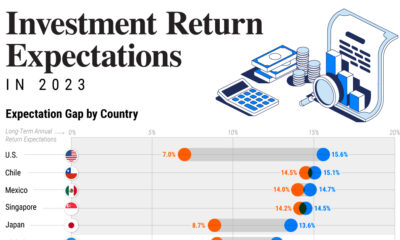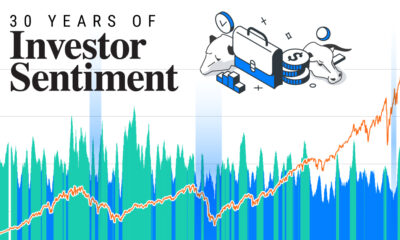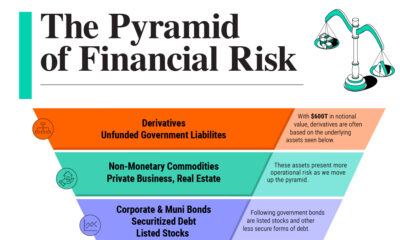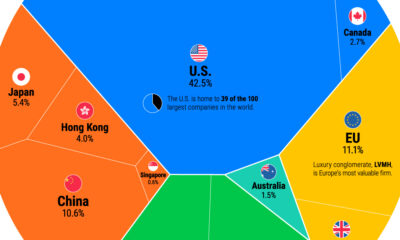All of the S&P 500 Sectors and Industries, by Size
View the high resolution version of this infographic. Buy the poster.
The S&P 500 is one of the most widely quoted stock market indexes, but do you know how it’s comprised? From soft drinks to semiconductors, the benchmark index tracks an extremely wide variety of industries across the U.S. economy.
In this Markets in a Minute chart from New York Life Investments, we show every sector and its underlying industries by size.
A Sector View
At a high level, the S&P 500 tracks broad segments of the economy known as sectors. Here’s how the percentage allocation in the index breaks down:
| Sector | Percent of S&P 500 Index |
| Information Technology | 27.48% |
| Health Care | 14.58% |
| Consumer Discretionary | 11.18% |
| Communication Services | 10.90% |
| Financials | 9.89% |
| Industrials | 7.90% |
| Consumer Staples | 7.05% |
| Utilities | 3.13% |
| Real Estate | 2.80% |
| Materials | 2.56% |
| Energy | 2.53% |
Data as of July 31, 2020.
Information technology, which makes up almost 28% of the index, has outperformed other sectors by a wide margin so far in 2020. At the other end of the spectrum, real estate, materials, and energy each make up less than 3% of the index.
Diving Deeper: An Industry View
While investors are likely familiar with sectors, the specific underlying industries may be lesser known. Below is a complete industry breakdown of the S&P 500.
Click “Next” to view industry breakdowns of each sector
| Sector | Industry | % of Sector |
| Communication Services | | |
| Advertising | 0.63% |
| Alternative Carriers | 0.32% |
| Broadcasting | 1.23% |
| Cable & Satellite | 9.86% |
| Integrated Telecommunication Services | 15.22% |
| Interactive Home Entertainment | 4.18% |
| Interactive Media & Services | 51.52% |
| Movies & Entertainment | 14.69% |
| Publishing & Printing | 0.22% |
| Communication Services (cont'd) | Wireless Telecommunication Services | 2.12% |
| Consumer Discretionary | | |
| Apparel Retail | 3.39% |
| Apparel, Accessories & Luxury Goods | 1.27% |
| Auto Parts & Equipment | 0.94% |
| Automobile Manufacturers | 1.89% |
| Automotive Retail | 2.97% |
| Casinos & Gaming | 0.98% |
| Computer & Electronics Retail | 0.75% |
| Consumer Electronics | 0.47% |
| Consumer Discretionary (cont'd) | Department Stores | 0.10% |
| Distributors | 0.71% |
| Footwear | 4.00% |
| General Merchandise Stores | 4.40% |
| Home Furnishings | 0.33% |
| Home Improvement Retail | 13.16% |
| Homebuilding | 2.19% |
| Hotels, Resorts & Cruise Lines | 2.05% |
| Household Appliances | 0.34% |
| Housewares & Specialties | 0.21% |
| Consumer Discretionary (cont'd) | Internet & Direct Marketing Retail | 47.65% |
| Leisure Products | 0.31% |
| Restaurants | 10.44% |
| Specialized Consumer Services | 0.09% |
| Specialty Stores | 1.36% |
| Consumer Staples | | |
| Agricultural Products | 1.25% |
| Brewers | 0.37% |
| Distillers & Vintners | 2.23% |
| Drug Retail | 1.57% |
| Consumer Staples (cont'd) | Food Distributors | 1.41% |
| Food Retail | 1.43% |
| Household Products | 26% |
| HyperMarkets & Super Centers | 17.15% |
| Packaged Foods & Meats | 14.79% |
| Personal Products | 2.39% |
| Soft Drinks | 21.13% |
| Tobacco | 10.28% |
| Energy | | |
| Integrated Oil & Gas | 50.88% |
| Energy (cont'd) | Oil & Gas Equipment & Services | 8.13% |
| Oil & Gas Exploration & Production | 20.30% |
| Oil & Gas Refining & Marketing | 11.51% |
| Oil & Gas Storage & Transportation | 9.18% |
| Financials | | |
| Asset Management & Custody Banks | 8.08% |
| Consumer Finance | 4.40% |
| Diversified Banks | 27.43% |
| Financial Exchanges & Data | 11.91% |
| Insurance Brokers | 5.77% |
| Financials (cont'd) | Investment Banking & Brokerage | 6.63% |
| Life & Health Insurance | 4.08% |
| Multi-line Insurance | 1.84% |
| Multi-Sector Holdings | 14.23% |
| Property & Casualty Insurance | 7.41% |
| Regional Banks | 7.91% |
| Reinsurance | 0.33% |
| Health Care | | |
| Biotechnology | 15.66% |
| Health Care Distributors | 1.65% |
| Health Care (cont'd) | Health Care Equipment | 25.73% |
| Health Care Facilities | 1.06% |
| Health Care Services | 4.80% |
| Health Care Supplies | 1.64% |
| Health Care Technology | 0.54% |
| Life Sciences Tools & Services | 8.56% |
| Managed Health Care | 11.30% |
| Pharmaceuticals | 29.08% |
| Industrials | | |
| Aerospace & Defense | 20.41% |
| Industrials (cont'd) | Agricultural & Farm Machinery | 2.58% |
| Air Freight & Logistics | 7.85% |
| Airlines | 2.27% |
| Building Products | 5.57% |
| Construction & Engineering | 0.78% |
| Construction Machinery & Heavy Trucks | 6.61% |
| Diversified Support Services | 2.09% |
| Electrical Components & Equipment | 5.66% |
| Environmental & Facilities Services | 3.20% |
| Human Resource & Employment Services | 0.27% |
| Industrials (cont'd) | Industrial Conglomerates | 13.56% |
| Industrial Machinery | 10.12% |
| Railroads | 11.13% |
| Research & Consulting Services | 4.11% |
| Trading Companies & Distributors | 2.48% |
| Trucking | 1.32% |
| Information Technology | | |
| Application Software | 8.79% |
| Communications Equipment | 3.42% |
| Data Processing & Outsourced Services | 15.67% |
| Information Technology (cont'd) | Electronic Components | 0.74% |
| Electronic Equipment & Instruments | 0.53% |
| Electronic Manufacturing Services | 0.48% |
| Internet Services & Infrastructure | 0.54% |
| IT Consulting & Other Services | 4.27% |
| Semiconductor Equipment | 1.95% |
| Semiconductors | 15.10% |
| Systems Software | 24.00% |
| Technology Distributors | 0.22% |
| Technology Hardware, Storage & Peripherals | 24.29% |
| Materials | | |
| Commodity Chemicals | 6.71% |
| Construction Materials | 4.11% |
| Copper | 2.71% |
| Diversified Chemicals | 1.46% |
| Fertilizers & Agricultural Chemicals | 6.71% |
| Gold | 8.02% |
| Industrial Gases | 27.73% |
| Metal & Glass Containers | 3.47% |
| Paper Packaging | 8.80% |
| Materials (cont'd) | Specialty Chemicals | 28.45% |
| Steel | 1.82% |
| Real Estate | | |
| Health Care REITs | 6.78% |
| Hotel & Resort REITs | 1.00% |
| Industrial REITs | 12.24% |
| Office REITs | 5.85% |
| Real Estate Services | 1.94% |
| Residential REITs | 11.20% |
| Retail REITs | 7.51% |
| Real Estate (cont'd) | Specialized REITs | 53.48% |
| Utilities | | |
| Electric Utilities | 62.41% |
| Gas Utilities | 1.53% |
| Independent Power Producers & Energy Traders | 1.20% |
| Water Utilities | 3.15% |
| Multi-Utilities | 31.71% |
Data as of July 31, 2020.
In total, the S&P 500 tracks 126 industries, and each one presents unique risks and opportunities.
Biotechnology, which focuses on novel drug development and clinical research for treating diseases, has gained renewed interest during the COVID-19 pandemic. While successful drugs can offer high potential returns, about 90% of clinical programs ultimately fail. Investors can screen potential companies for various factors including corporate sponsor support, ample long-term funds, and a pipeline with more than one product.
Another example is aerospace and defense. Due to the high barriers to entry and significant funding from the U.S. government, this can be an attractive industry for investors. However, it can be impacted by the current government’s defense policies. For example, the aerospace and defense industry performed well after President Donald Trump was elected, and it may be influenced by the November 2020 election results.
The Big Picture
With a full view of the S&P 500 sectors and industries, investors can get a better idea of the opportunities within U.S. large cap stocks. However, it’s worth noting that it is not possible to invest directly in an index. Investors can put funds in these industries by purchasing stocks directly, or through managed products such as ETFs and mutual funds that track index performance.
By exploring every corner of the economy, investors can take advantage of growth potential in various areas—not just those trending in the news cycle.

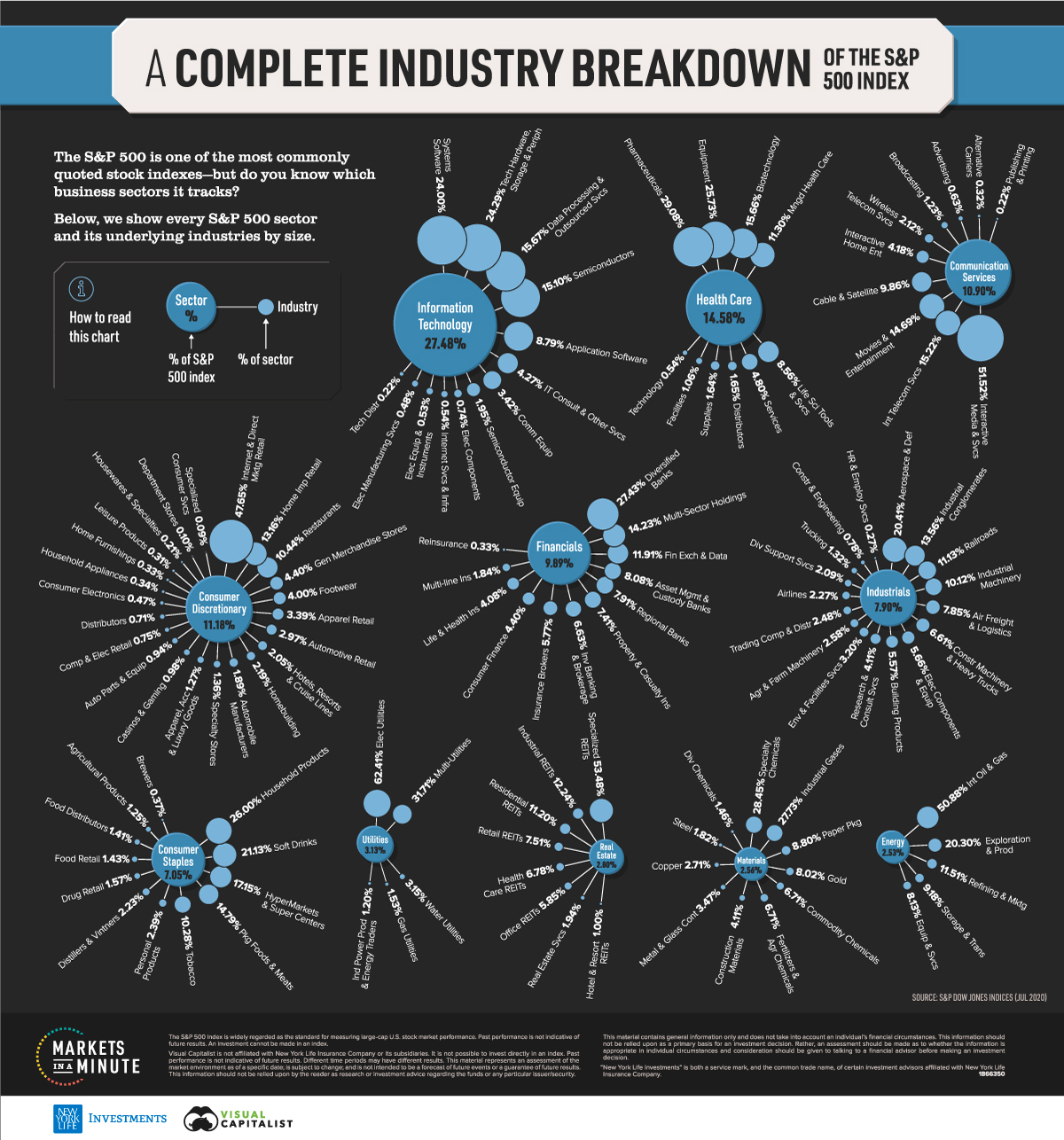
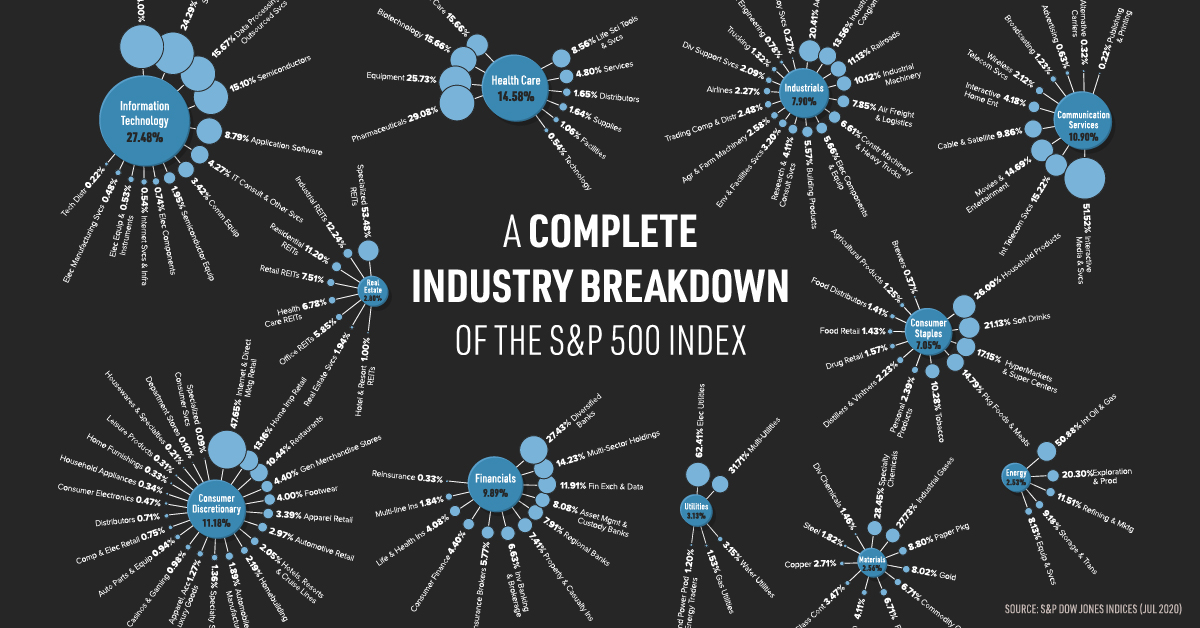

 Infographics2 years ago
Infographics2 years ago
 Markets in a Minute2 years ago
Markets in a Minute2 years ago
 Markets in a Minute2 years ago
Markets in a Minute2 years ago
 Infographics2 years ago
Infographics2 years ago
 Markets in a Minute1 year ago
Markets in a Minute1 year ago
 Markets in a Minute2 years ago
Markets in a Minute2 years ago
 Infographics1 year ago
Infographics1 year ago
 Markets in a Minute2 years ago
Markets in a Minute2 years ago



